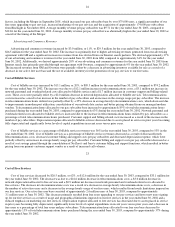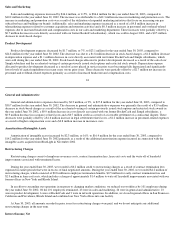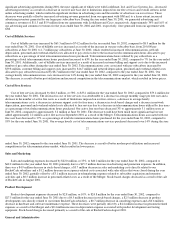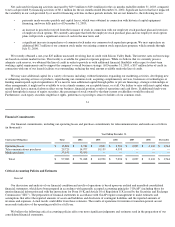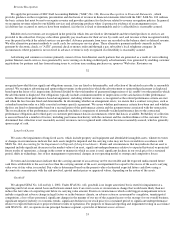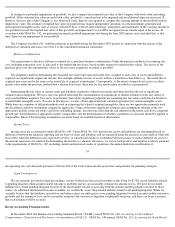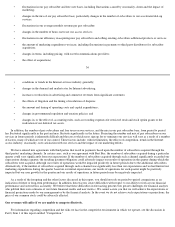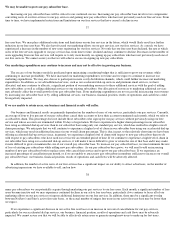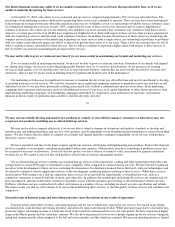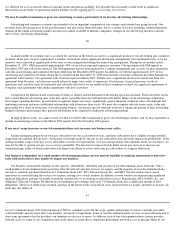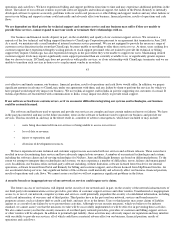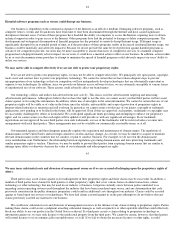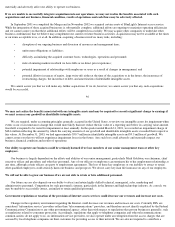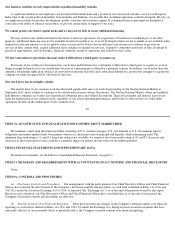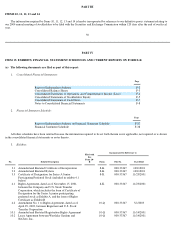Classmates.com 2003 Annual Report Download - page 29
Download and view the complete annual report
Please find page 29 of the 2003 Classmates.com annual report below. You can navigate through the pages in the report by either clicking on the pages listed below, or by using the keyword search tool below to find specific information within the annual report.
•
fluctuations in our pay subscriber and free user bases, including fluctuations caused by seasonality, churn and the impact of
marketing;
• changes in the mix of our pay subscriber base, particularly changes in the number of subscribers to our accelerated dial-up
services;
• fluctuations in our average monthly revenue per pay subscriber;
• changes in the number of hours users use our access services;
• fluctuations in our efficiency in acquiring new pay subscribers and selling existing subscribers additional products or services;
• the amount of marketing expenditures we incur, including fluctuations in payments to third party distributors for subscriber
acquisition;
• changes in terms, including pricing, with our telecommunications providers;
• the effect of acquisitions;
36
• conditions or trends in the Internet services industry generally;
• changes in the demand and market rates for Internet advertising;
• increases or reductions in advertising and commerce revenues from significant customers;
• the effects of litigation and the timing of resolutions of disputes;
• the amount and timing of operating costs and capital expenditures;
• changes in governmental regulation and taxation policies; and
• changes in, or the effect of, accounting rules, such as recording expenses for restricted stock and stock option grants or the
realization of our deferred tax assets.
In addition, the number of pay subscribers and free users on our services, and the mix in our pay subscriber base, from period to period
has fluctuated significantly in the past and may fluctuate significantly in the future. Projecting the number and mix of pay subscribers on our
services in future periods is inherently difficult and the rate at which users sign up for or terminate our services will vary as a result of a number
of factors, many of which are out of our control. These factors include, without limitation, the effects of competition, trends in the Internet
access industry, seasonality, user satisfaction with our services and the impact of our marketing efforts.
We have entered into agreements with third parties that result in payments based upon the number of subscribers acquired through the
third parties' marketing channels. In certain cases, such as our agreement with Best Buy, the number of subscribers acquired during a particular
quarter could vary significantly from our expectations. If the number of subscribers acquired through such a channel significantly exceeded our
expectations during a quarter, the resulting payment obligation could adversely impact our results of operations in the quarter during which the
subscribers were acquired, although our results of operations would be impacted positively in future periods due to the additional subscribers.
Alternatively, if the number of subscribers acquired through such a channel was significantly less than our expectations and we had limited our
marketing expenditures during the quarter based on our initial expectations, our results of operations for such quarter might be positively
impacted but our user growth for the quarter and our results of operations in future periods may be negatively impacted.
As a result of the foregoing and the other factors discussed in this report, you should not rely on period-to-period comparisons as an
indication of future or long-term performance. In addition, these factors create difficulties with respect to our ability to forecast our financial
performance and user metrics accurately. We believe that these difficulties in forecasting present even greater challenges for financial analysts
who publish their own estimates of our future financial results and user metrics. We cannot assure you that we will achieve the expectations or
financial projections made by our management or by the financial analysts. In the event we do not achieve such expectations or projections, the
price of our common stock could be adversely affected.
Our revenues will suffer if we are unable to compete effectively.
For information regarding competition and the risks we face in the competitive environment in which we operate, see the discussion in
Part I, Item 1 of this report entitled "Competition."


